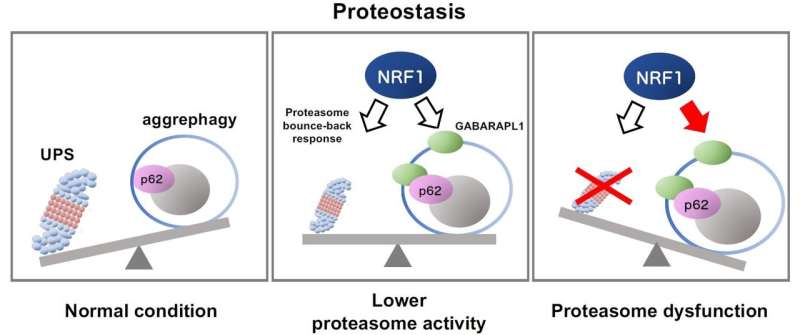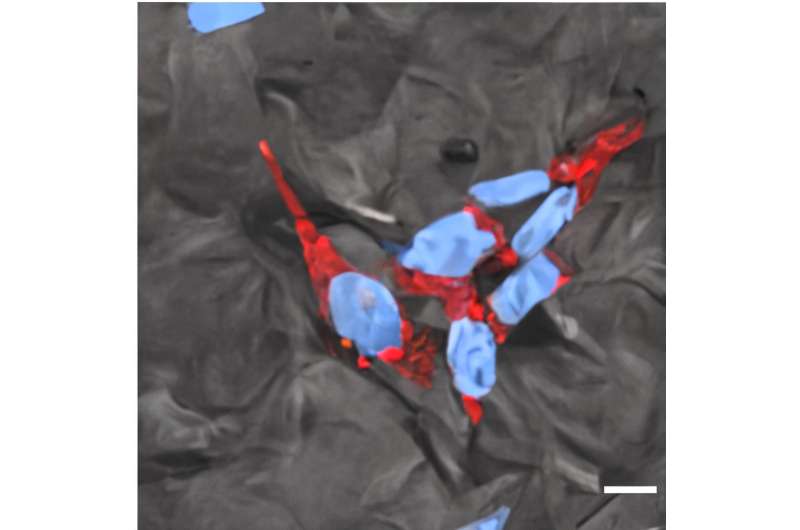This article has been reviewed according to Science X's editorial process and policies. Editors have highlighted the following attributes while ensuring the content's credibility:
fact-checked
peer-reviewed publication
trusted source
proofread
Study reveals novel therapeutic target to eliminate unwanted and misfolded proteins

Biological cells contain in-built "housekeeping" mechanisms for taking care of damaged cellular structures. This includes the ubiquitin‒proteasome system (UPS), which selectively tags unwanted proteins with the ubiquitin molecule, and then clears them. When the UPS mechanism fails, cells activate a compensatory protein clearance process called "aggrephagy," in which protein aggregates are degraded by the cell in a controlled manner. However, thus far, the mechanism behind aggrephagy has been unknown.
Now, a paper published in Scientific Reports, reveals the underlying mechanism. "Our study demonstrates that the activation of aggrephagy is induced by the transcription factor NRF1 (NFE2L1) in response to proteasome dysfunction," explains Atsushi Hatanaka, graduate student at Doshisha University, Japan, who is the first author of the study.
The research team also included Sota Nakada and Akira Kobayashi, both from the Laboratory for Genetic Code, Graduate School of Life and Medical Sciences, Doshisha University.
NRF1, a protein involved in the transcription of DNA to RNA, plays a key role in the balance and regulation of proteins. It upregulates proteasome genes when the proteasome is damaged.
As a part of the study, the team first used small interfering RNA (siRNA) to reduce the activity of the NRF1 synthesis gene in a cellular model. They then used the inhibitor MG132 to block proteasome-mediated protein recycling. These treatments led to the accumulation of undesired proteins in the cellular model, indicating that the absence of NRF1 effectively inhibited aggrephagy activation, which is otherwise typically prevalent in a cell.

The researchers then examined the effect of proteasome inhibition on genes that were direct targets of NRF1. During the course of experiments, the team noticed that in response to proteasomal failure, NRF1 caused an increase in the levels of the autophagy-related genes p62 and GABARAPL1.
The elevated levels of the corresponding proteins p62 and GABARAPL1 resulted in the removal of proteins that were tagged for removal by the housekeeping protein ubiquitin. In other words, NRF1 was found to trigger the process of aggrephagy via p62 and GABARAPL1 as a direct physiological response to proteasomal failure.
Next, the team also discovered that the presence of NRF1 was necessary for the formation of p62-positive puncta—tiny round cellular structures loaded with large amounts of the protein p62. Moreover, it became evident that the colocalization (physical proximity) of the proteins p62, ULK1, and TBK1 was necessary for the activation of p62. Thi
s activation is considered to be the direct result of phosphorylation—the addition of phosphate groups to proteins. A series of experiments revealed that the phosphorylation of p62 was facilitated by NRF1. The phosphorylated p62 then contributed to the process of aggrephagy. As mentioned before, a similar increase in aggrephagy was also observed after the NRF1-mediated increase in the levels of the protein GABARAPL1.
Explaining the novelty of the research, Mr. Hatanaka says, "Although NRF1 has been previously shown to upregulate proteasome genes when the proteasome is dysfunctional, our genome-wide transcriptome analyses showed that NRF1 directly upregulates autophagy-related genes p62 and GABARAPL1."
These findings pave the way toward the development of novel therapeutics for degenerative diseases such as Alzheimer's disease, Parkinson's disease, and dementia with Lewy bodies—all of which are caused by the accumulation of misfolded proteins.
More information: Atsushi Hatanaka et al, The transcription factor NRF1 (NFE2L1) activates aggrephagy by inducing p62 and GABARAPL1 after proteasome inhibition to maintain proteostasis, Scientific Reports (2023). DOI: 10.1038/s41598-023-41492-9
Journal information: Scientific Reports
Provided by Doshisha University



















